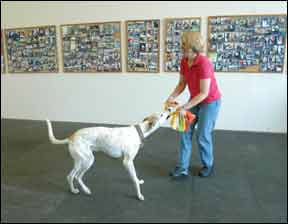You can train your dog without using treats by identifying and utilizing other types of rewards such as snuggling, walks, toys, and attention. Real-life rewards can be effective in motivating your dog to obey commands without relying on food treats.
Clicker training in combination with non-food rewards like praise or playtime with their favorite toy can also be a successful training method for dogs who aren’t motivated by food. Additionally, you can use tug-of-war as a way to teach your dog to drop items.
By presenting a toy and engaging in play, eventually your dog will drop the toy on their own, which can be reinforced with praise and another game of tug. There are various ways to reward your dog without treats, allowing for effective training and a happy, well-behaved companion.

Credit: www.whole-dog-journal.com
Training Without Treats: An Effective Approach For Dog Owners
Discover effective techniques for dog training without the use of treats. Learn how to motivate your dog using real-life rewards such as walks, toys, and attention. Find alternative methods like clicker training with non-food rewards to achieve obedience without relying on treats.
When it comes to training dogs, treats are often seen as the go-to motivator. However, relying solely on treat-based training can have its limitations. While treats can be effective in the beginning stages of training, they may not always work in more challenging situations or with certain dogs. It is important for dog owners to understand these limitations and explore alternative approaches for effective training. Fortunately, there are alternative motivators that can be just as effective, if not more so, than treats when it comes to training dogs. Real-life rewards, such as snuggling, walks, toys, and attention, are non-food activities that dogs enjoy. By identifying what motivates your dog, you can encourage them to obey commands without relying solely on food treats. These alternative motivators can be a valuable tool in your training arsenal. Training without treats requires a different approach than traditional treat-based training. One method is clicker training, which involves using a clicker to mark desired behaviors, followed by a reward that is not food-related. This could be praise or playtime with a favorite toy. Another method is utilizing environmental rewards, such as allowing your dog access to something they desire, like a toy or a favorite sniffing spot, as a reward for good behavior. These methods can be effective in training your dog without relying on treats. Training without treats may present its own set of challenges. Some dogs may initially resist or become confused by the absence of treats, as they have come to associate them with rewards. Consistency and patience are key in overcoming these challenges. It is important to clearly communicate to your dog that their desired reward will come from alternative motivators. Praise and reinforce their good behavior with real-life rewards to reinforce the training process. To ensure successful training without treats, consider the following tips:- Start by using treats in the initial stages of training to establish desired behaviors.
- Gradually reduce the reliance on treats and introduce alternative motivators.
- Be consistent in your training approach and expectations.
- Use positive reinforcement and plenty of praise to reward and reinforce good behavior.
- Observe your dog’s preferences and tailor your training to their unique motivators.
- Keep training sessions short and engaging to maintain focus and interest.
Understanding The Limitations Of Treat-based Training
In the world of dog training, treats have often been hailed as the go-to motivator. While they can serve as a useful tool, it’s important to understand the limitations of treat-based training. Over-reliance on treats can lead to loss of control and can hinder your dog’s overall training progress. By recognizing these limitations, we can explore other motivators and create a well-rounded training approach.
The Reliance On Treats As A Primary Motivator
Treats are undeniably effective in capturing a dog’s attention and encouraging desired behaviors. When used strategically, they can quickly reinforce positive actions and establish a strong foundation for learning. However, relying solely on treats can create an unhealthy dependency. Dogs may become fixated on the treats rather than truly understanding and internalizing the commands. This can undermine your control and make it difficult to achieve reliable obedience in real-life situations.
The Potential For Over-reliance And Loss Of Control
While treats can be a powerful motivator in controlled settings, they may lose their efficacy in distracting or high-stress environments. Your dog may become disinterested or choose to ignore commands if they don’t see an immediate reward on offer. This over-reliance on treats can hinder progress and create a dependency on external incentives rather than fostering an intrinsic desire to obey. It’s important to establish reliable control and responsiveness without the constant need for treats.
The Need For Other Motivators To Create A Well-rounded Training Approach
To create a well-rounded training approach, it’s crucial to introduce other motivators alongside treats. Real-life rewards, such as snuggling, walks, toys, and attention, can be just as powerful as food treats. By identifying what truly motivates your dog, you can create a range of incentives that go beyond food. This variety encourages your dog to respond in different situations and helps to solidify their training in real-world scenarios.
Additionally, incorporating positive reinforcement techniques such as clicker training can be a valuable tool. Clicker training provides instant feedback and bridges the communication gap between humans and dogs. By combining clicker training with non-food rewards like praise or playtime with their favorite toy, you can maintain motivation and achieve lasting results.
Exploring Alternative Motivators For Training
When it comes to dog training, many pet owners rely on treats as the primary motivator. However, there are alternative ways to train your dog without the use of food rewards. Exploring alternative motivators for training can help you build a stronger bond with your furry friend and create a well-behaved dog.
Real-life Rewards: Snuggling, Walks, Toys, And Attention
One of the most effective alternative motivators for dog training is real-life rewards. These are non-food activities that your dog enjoys and finds rewarding. Examples of real-life rewards include snuggling, going for walks, playing with toys, and providing them with attention.
By identifying your dog’s favorite activities and making them part of the training process, you can reinforce positive behavior without relying on treats. For instance, if your dog loves playing with a particular toy, you can use it as a reward for following commands or performing desired behaviors.
Clicker Training Combined With Non-food Rewards
Clicker training is another effective method that can be combined with non-food rewards. The clicker serves as a secondary reinforcer, indicating to your dog that they have performed the desired behavior correctly.
After a click, you can follow it up with a non-food reward such as praise or playtime with your dog’s favorite toy. This combination reinforces positive behavior and helps your dog understand that they have done something right.
Using Praise And Playtime As Rewards
Praising your dog and providing them with playtime can be powerful rewards during training sessions. Dogs thrive on positive reinforcement, and verbal praise can go a long way in motivating them.
Incorporating playtime into training can also be highly effective. Dogs love to engage in interactive activities and play with their owners. You can play fetch, tug-of-war, or any other game that your dog enjoys as a reward for their good behavior.
Remember, the key to successful training without treats is to find what motivates your dog and use it as a reward. By incorporating real-life rewards, clicker training, praise, and playtime into your training sessions, you can create a happy and well-behaved dog without relying on food treats.

Credit: www.amazon.com
Methods For Training Without Treats
Training your dog without treats is possible by using alternative rewards such as snuggling, walks, toys, and attention. Clicker training in combination with non-food rewards like praise or playtime can also be effective. Additionally, using toys and real-life rewards can help motivate your dog to obey commands without relying on food treats.
Teaching Obedience Through Motivational Tools
Training a dog without treats doesn’t mean you can’t motivate them to learn. In fact, there are various other tools and rewards you can use to reinforce obedience. Motivational tools such as praise, toys, walks, and attention can be just as effective in encouraging your dog to obey commands.
Avoidance Training: Understanding The Concept And Application
Avoidance training is a method where dogs learn to avoid certain behaviors or actions that result in negative consequences. By implementing clear boundaries and using corrective techniques, you can teach your dog to understand what behaviors are unacceptable. This approach requires consistency, patience, and a thorough understanding of your dog’s individual needs.
Escape Training: A Method For Creating Desired Behaviors
Escape training is a technique that involves providing your dog with a way to escape or avoid an aversive situation or stimulus. By teaching your dog a specific behavior that allows them to escape from an uncomfortable situation, you can shape desired behaviors. This method often involves using a designated cue or signal that indicates to the dog that they can leave the situation, rewarding them with freedom and relief.
Meal Time Training: Utilizing Regular Feeding Schedules
Meal time training takes advantage of your dog’s regular feeding schedule to reinforce obedience. Instead of using treats, you can use their meals as rewards during training sessions. By incorporating training exercises before or during meal times, you can create a positive association between obedience and their regular feeding routine.
Continual Reinforcement Training: Developing Consistent Behavior Patterns
Continual reinforcement training focuses on developing consistent behavior patterns through the use of positive reinforcement. This method involves rewarding your dog for displaying the desired behavior consistently over time. By providing praise, affection, or playtime as rewards, you can reinforce good behavior and encourage your dog to continue displaying it.
Free Shaping: Encouraging Creativity And Problem-solving
Free shaping is a training technique that encourages creativity and problem-solving in dogs. It involves rewarding and shaping behaviors that are closer and closer to the desired behavior. By breaking down complex commands into small steps and rewarding each successful attempt, you can guide your dog towards the desired behavior while allowing them to use their natural problem-solving abilities.
The Role Of Anchoring In Training
Anchoring in training refers to the process of creating associations between specific cues or signals and desired behaviors. By consistently pairing a verbal or visual cue with a specific action or behavior, you can anchor the cue in your dog’s mind. This allows you to communicate your expectations clearly and helps your dog understand what is expected of them in different situations.
Progression Through Different Stages Of Training
To effectively train your dog without treats, it’s important to understand the progression through different stages of training. Each stage builds upon the previous one, gradually increasing the difficulty and complexity of the commands. By starting with basic obedience commands and gradually introducing more advanced skills, you can ensure a solid foundation of obedience in your dog.
Addressing Common Challenges
Discover effective techniques for dog training without the use of treats. Explore alternative rewards such as playtime, toys, walks, and attention that can motivate your furry friend to obey commands. Learn how to train your dog using non-food incentives for a well-behaved and happy companion.
Training Dogs With Low Food Motivation
If you’re training a dog with low food motivation, it can be challenging to find effective training techniques. However, there are alternative rewards and motivators that can be used to shape their behavior. Real-life rewards such as snuggling, walks, toys, and attention can be just as effective as treats. By identifying what your dog enjoys and using those rewards, you can encourage them to obey commands without relying on food treats.
Dealing With Distractions And Maintaining Focus
Distractions can pose a significant challenge when training a dog without treats. To maintain focus, it’s essential to create a training environment that minimizes distractions. Start in a quiet and controlled space before gradually introducing more distractions. Consistency and repetition are key to reinforcing the desired behavior. Utilize techniques such as positive reinforcement through praise, playtime with their favorite toy, or even clicker training in combination with non-food rewards.
Building Trust And Strengthening The Owner-dog Bond
Training dogs without treats can be an excellent way to build trust and strengthen the bond between an owner and their furry companion. By using positive reinforcement techniques and clear communication, you can establish a relationship based on trust, respect, and mutual understanding. This includes providing consistent cues, setting clear expectations, and rewarding desired behavior with non-food rewards. A strong bond and a clear understanding of each other’s needs will lead to a well-behaved and obedient dog.
Adapting Techniques For Different Dog Breeds And Personalities
Each dog breed and personality is unique, requiring specific training techniques. When training without treats, it’s crucial to adapt your methods to suit your dog’s individual needs. Some dogs respond better to praise and play, while others might prefer interactive toys or engaging activities. Understanding your dog’s breed characteristics and personality traits will help tailor your training approach effectively. By incorporating techniques that resonate with your dog’s innate preferences, you can maximize their learning potential and achieve desired results.
Tips For Successful Training Without Treats
When it comes to dog training, many owners turn to treats as the go-to reward. However, it is possible to train your furry friend effectively without the use of treats. In this section, we will explore some valuable tips that can help you achieve successful training without relying on food rewards.
Setting Clear Training Goals And Expectations
Before diving into training sessions, it’s essential to establish clear goals and expectations. Determine what specific behaviors you want your dog to learn and make sure you communicate these expectations consistently during training. By setting clear goals, you provide structure and direction for both you and your pet, making the training process more effective.
Balancing The Use Of Rewards And Corrections
While treats may not be the primary reward, it doesn’t mean that rewards should be entirely eliminated from the training process. Balancing the use of rewards and corrections is crucial for successful training. Implementing praise, petting, or playtime as rewards can positively reinforce desired behaviors, while mild corrections such as redirecting attention or withdrawing attention can discourage unwanted behaviors. This balance establishes a clear understanding for your dog and promotes learning.
Creating A Positive And Stimulating Training Environment
A positive and stimulating training environment can be a game-changer when it comes to successful training without treats. Dogs thrive in an environment that offers mental and physical engagement. Incorporating interactive toys, challenges, and playtime into your training sessions keeps your dog motivated and eager to participate. Additionally, ensure that the training space is free from distractions, allowing your dog to focus solely on the training tasks at hand.
Consistency And Patience: Key Factors For Success
Consistency and patience are key factors in any dog training journey, and training without treats is no exception. Consistency in commands, expectations, and consequences helps your dog better understand what is expected of them. Patience is vital as dogs need time to grasp and internalize new behaviors. Be patient and understanding throughout the training process, celebrating small victories and remaining consistent in your approach.
Seeking Professional Guidance And Support When Needed
While training without treats can be rewarding, there may be instances where professional guidance and support are necessary. Whether you’re struggling with specific behaviors or need expert advice, reaching out to a professional dog trainer can provide invaluable assistance. They can assess your dog’s specific needs and tailor a training plan that aligns with your goals.

Credit: m.youtube.com
Frequently Asked Questions On Dog Training Without Treats
Can I Train My Dog Without Using Treats?
Yes, you can train your dog without using treats. You can use real-life rewards like snuggling, walks, toys, and attention as motivation. Additionally, you can try clicker training with non-food rewards such as praise or playtime with their favorite toy.
How Do You Train A Dog When Treats Dont Work?
To train a dog when treats don’t work, you can try using alternatives like clicker training with praise or playtime using their favorite toy. Real-life rewards such as walks, snuggling, and attention can also be motivating. Additionally, you can use a toy your dog wants as a reward for walking on a loose lead or use tug-of-war to teach them to drop items.
How Do You Train A Dog To Lead Without Treats?
To train a dog to lead without treats, you can use alternative rewards like playtime with their favorite toy, praise, snuggling, walks, attention, or brushing. Place something your dog wants on the floor, like a toy, and when they pull on the lead, stop and call them towards you.
Reward them by allowing them to reach the toy when they walk on a loose lead. Another option is using tug-of-war to teach them to drop objects.
How Do You Teach Your Dog To Drop It Without Treats?
To teach your dog to drop it without treats, try using tug-of-war. Start playing with a toy and then go still. Your dog will eventually get bored and drop the toy. Praise them and reward them with another game of tug.
You can also use non-food rewards like snuggling, walks, toys, and attention as motivation.
Conclusion
To train your dog without treats, you can use alternative rewards such as snuggling, walks, toys, and attention. These real-life rewards can motivate your dog to obey commands without relying on food treats. Clicker training in combination with non-food rewards like praise or playtime with their favorite toy can also be effective.
Remember to identify your dog’s life rewards to encourage obedience in a treat-free training approach.







